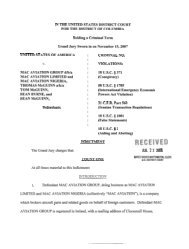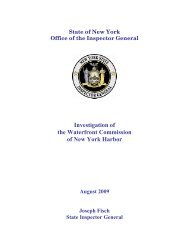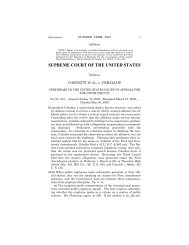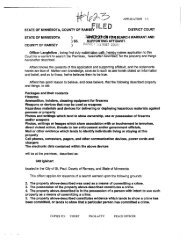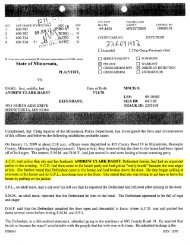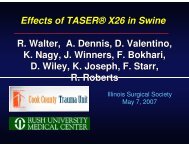TASER Electronic Control Devices Review Of Safety Literature
TASER Electronic Control Devices Review Of Safety Literature
TASER Electronic Control Devices Review Of Safety Literature
Create successful ePaper yourself
Turn your PDF publications into a flip-book with our unique Google optimized e-Paper software.
margins of about 200:1 or more for permanent electroporation of the heart. FEM<br />
(finite element models) show that the safety margins protecting the heart from<br />
electroporation are enormous. 81,101<br />
The simplest argument against electroporation is to notice that strong (Level 4)<br />
static shocks can have a peak current of 30 A according to international specification.<br />
102 This is twice the peak current of the M26 and nearly 10 times the peak<br />
current of the X26. There is no case in recorded history of someone suffering<br />
electroporation damage from a static shock.<br />
2.12 The <strong>TASER</strong> ECD Cannot Cause Cardiac or Remote Burns<br />
Another way in which an electric stimulus could cause heart cell death is by generating<br />
enough heat to “cook” some heart tissue. (Depending on the temperature,<br />
this may be referred to as cauterization or ablation). The effect of high voltage<br />
and high currents on the heart has been well studied. Exposure to high voltage<br />
and high current from lightning strikes or power line electrocution has been<br />
shown to cause contraction band necrosis involving the atrial and ventricular<br />
myocardium, tunica media of the medium and large coronary arteries, and the<br />
sinus and AV nodes. 103-106 These focal changes affecting the myocardium were<br />
extensive throughout the ventricles and atria. The vascular injury due to endothelial<br />
damage, smooth muscle contraction band necrosis, disseminated intravascular<br />
coagulation, and hypertensive chemoreflex contributed to the acute and late<br />
thrombosis and vessel rupture, manifesting in myocardial infarction and intramural<br />
hemorrhages. 107 Hearts were described to be normal in outside appearance,<br />
except for a few petechiae.<br />
Ablation requires the tissue to be raised to about 55° C. The <strong>TASER</strong> X26 pulse<br />
has 70 mJ (millijoules) of energy and delivers 19 pps for 5 seconds. There are 95<br />
pulses, which thus together deliver 6.65 J of energy. One joule of energy is<br />
0.2388 calories of heat. Therefore, 1.59 calories are delivered which will raise the<br />
temperature of 1 cc of water by 1° C. Thus, the speculation of the <strong>TASER</strong> device<br />
causing any ablation beyond a few mm from the tiny barb is fanciful.<br />
The <strong>TASER</strong> X26 heating would warm 1 cc of water if there was no loss of heat to<br />
other tissues during the 5-second application. However, due to heat loss, the actual<br />
temperature increase would be far less. The body generates about 100 W at<br />
rest. Thus over a 5-second application the X26 is directly adding 5/500 or 1% to<br />
the body’s intrinsic heating. With an exercising, resisting, or struggling individual<br />
the percentage increase is far less.<br />
Assuming no cooling at all, a 5-second X26 application injects 1.59 calories of<br />
heat into the body. With a 180 pound subject, the average temperature increase<br />
would be:<br />
0.000019° C = 1.59 cal ÷ 180 lbs ÷ 454 g per lb<br />
44




